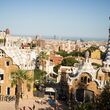The serpentine bench of Park Guell
The Nature Square, designed as an ancient agora, is located above the Hypostyle Room. It is the emblematic place of the park. You know it without having seen it because its long mosaic serpentine bench is one of the most photographed monuments in Barcelona, along with the Lizard in Park Guell.

The bench is 110m long and is said to be the longest corrugated bench in the world.
But what really catches the eye is its ergonomic shape designed for comfortable sitting and its famous mosaics.
Nature Square is oval in shape. It measures 2,694 m² (86 m long and 43 m wide).
The entire building was constructed between 1907 and 1913.

Here, more than anywhere else, Gaudi used the "trencadis" technique, which consisted of reusing fragments of recycled ceramics to create new decorative motifs, typical of Catalan Modernist architecture. This technique is also known as "pic-assiette". This bench is the best example.

We now know that these ceramics were made by Josep Maria Jujol i Gibert. A modernist architect and disciple of Gaudi whose role was inevitably overshadowed by that of the Master. Josep Maria Jujol i Gibert had a great sense of colour, and here we understand all the virtuosity of his poetry in the assembling of recycled elements. We also owe him the trencadis on the ceiling of the Hypostyle Hall in Park Guell, as well as the Casa Batlló, and his active participation in the construction of the Sagrada Família.

The Nature Square, formerly known as "The Greek Theatre".
The Nature Square in Park Güell was originally designed to host open-air shows. Its original name was "The Greek Theatre". The square was to be the stage, with the spectators standing outside the square or even on the terraces of their houses - houses that were never built. Although there were never any theatrical performances, the square occasionally hosted traditional Catalan shows, such as the Sardana dances.
Spontaneous Sardana dances today or, as in 1956, a real event with the "Federación de Carrers de la Festa Major de Gràcia" festival, bringing together dozens of couples to celebrate the legendary 12 hours of Sardana dances in Park Güell. Another era!

Technically, the square is composed of a part dug into the rock and another part supported by a hypostyle hall. The undulating bench and the retaining wall with palm-shaped capitals delimit the square.
